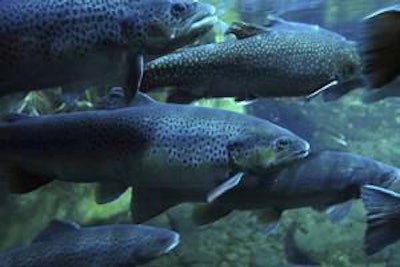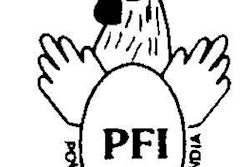
Grain-based aquaculture diets can reduce the amount of fish meal fed, and improve water quality by reducing the amount of phosphorus in fish effluent. However, from a fish’s standpoint, grain-based diets have a rather large disadvantage – they are low in protein.
Most grains contain less than 40 percent protein, and trout, for example, need a diet that is 40 percent to 50 percent protein, depending on life stage. Feed manufacturers have a hard time reaching the needed protein level without using expensive ingredients or ingredients that can inhibit feed conversion.
However, now researchers are testing processes to modify grains and other feed ingredients to boost crude protein levels and improve feed value for the least cost.
Modifying ingredients
“We’re modifying ingredients to increase protein or remove anti-nutrients,” said Rick Barrows, a fish nutritionist with the U.S. Department of Agriculture Agricultural Research Service in Bozeman, Mont.
One of those methods is an air classifier. John Hamilton, founder of Adaptive Bio-Resources, LLC, has installed a pilot-size air classifier in the Bozeman lab. The equipment was never intended for use in feed mills, it was actually designed to separate powders such as talc from coarse to fine.
However, Hamilton has run ingredients from algae to wheat through it. “The beauty of it is that we can concentrate proteins without using a lot of water,” Hamilton said. Every time water is added to a product to concentrate the protein, processors have to dry the product. Keeping the product dry from start to finish is not only more cost-effective, but it reduces the chances the product could be contaminated.
Improving protein
Barrows sees great promise for the classifier to take a waste product and make it more useful or a commodity and make it more valuable. “By improving the protein, we can add value and sell feed for $850 a ton instead of $200 to $250 a ton,” Barrows said.
An air classifier works by injecting the material stream to be sorted into a chamber which contains a column of rising air. Inside the separation chamber, air drag on the objects supplies an upward force, which counteracts the force of gravity and lifts the material to be sorted up into the air. Due to the air drag on object size and shape, the objects in the moving air column are sorted vertically and can be separated in this manner.
Denser materials drop through the wheel classifier, while finer materials go through the cyclone and then through four socks to get the ultra fines. Operators can adjust the revolutions of the wheel classifier and the airflow according to the material’s characteristics.
Once the material has been separated, the operator is left with distinct groups of product with unique properties. Tests have shown classifying barley can boost the protein level from 12 percent to 28 percent. That’s good enough for tilapia rations, but not aquafeeds for species that are primarily carnivorous, such as trout or salmon.
Benefits
Getting barley into trout feeds means a barley concentrate of 50 percent to 70 percent crude protein, and getting to that level will likely require the use of microbes. The ARS laboratory at Bozeman is experimenting with an enzymatic process patented by the USDA that a corporate partner hopes to commercialize in the near future.
Even ingredients that are high in protein, such as algae that is 58 percent to 60 percent protein, can benefit from being classified. Hamilton separated a batch of algae to demonstrate the point. The classifier divided the lot roughly into a 50-50 split with the darker material, the coarser material, and the lighter material, the fines. The lot had 60 percent crude protein before the split, with coarse material testing 61 percent and the lighter material 60 percent crude protein after the split.
“We didn't shift the protein much,” Hamilton said. But researchers hypothesize that classifying algae may remove non-nutrients that could make the ingredient a better alternative. The next step is to feed both the coarse ingredient and the fine ingredient to see which fish perform better on.
Pilot mill
Hamilton is testing a pilot mill at the U.S. Department of Agriculture Bozeman lab but is hoping to install a full-scale mill. He estimates a whole mill could be purchased for around $5 million and is looking at funding options.
However, low protein isn’t the only problem with barley – it’s also sticky. The same beta glucans (fiber) that make barley a heart healthy food for humans are indigestible fiber that may become viscous in the intestinal tract. Camelina, an alternative to soybean meal that is sometimes called wild flax, exhibits the same characteristic. Some animals such as poultry and fish lack the glucanese enzyme needed to break down beta glucans, and if fed a barley-based diet, they will always remain small.
Hamilton and Barrows are using a fat/lipid extractor to modify both barley and camelina in order to make it more useful in fish diets.
Boosting protein in oil seeds
Including soybean meal in fish feeds can help offset fish meal in the area of protein, but soybeans contain anti-nutrients that can have negative impacts on fish growth and health.
Of the anti-nutrients in soybeans, trypsin inhibitors are of the greatest concern to fish nutritionists. Trypsin inhibitors reduce protein digestibility by binding with the digestive enzyme trypsin in the intestine of the animal. Trypsin inhibitors are sensitive to heat, and ordinary processing after oil is extracted from raw soybeans lowers the level of trypsin inhibitors in the dried meal to levels that do not affect the growth of most domestic animals. However, salmon and trout are more sensitive. More extensive heat treatment is necessary to reduce residual trypsin inhibitor levels to levels that don’t affect protein digestibility and growth. However, processors have to be careful not to overcook the meal or fish won’t eat it.
Barrows is looking at using a one-step process to boost the protein level of soybean meal from 48 percent to 70 percent without overheating the meal. This food grade process does not involve ethanol, and therefore reduces the chances of explosion.
Barrows is also working with a company that is trying to breed anti-nutrients out of soybeans using traditional plant breeding methods. They are showing some success. Instead of 48 percent crude protein in conventional soybean meal, the soybeans for aquaculture feeds have 58 percent protein which is also more digestible. Running the resulting meal through the one-step extraction process can boost protein to 76 percent.
Numerous fish feeding studies have shown that fish can do just as well on diets made from alternate proteins as they do on diets formulated with fish meal, but processing matters. It is for this reason that modifying ingredients to maximize protein levels and reduce anti-nutrients is just as important as identifying new ingredients.

















